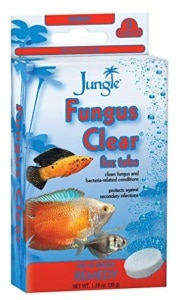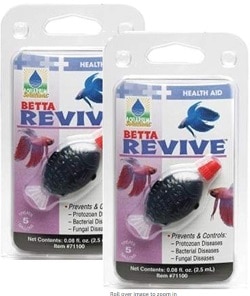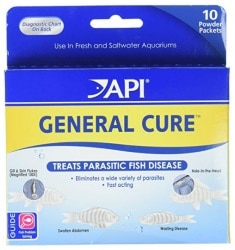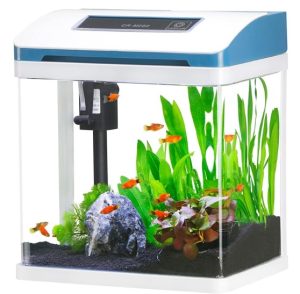Basic Guide To Betta Fish Diseases
Although betta fish are probably one of the easiest fish breeds to take care of, they are still quite sensitive to common betta fish diseases.
Betta fish can have a long life span, if they are not properly fed and cared for a betta fish will become ill and quite possibly die.
Having a sick Betta fish can be nerve-wracking, particularly if you are a new owner and have never dealt with this before. There are some Betta fish diseases that can be deadly, there are also many that can be easily cured if you are able to detect them early and get the right treatment. If you notice any strange behaviors in your fish, you need to look at diagnosing as soon as possible. To ensure that this is done correctly you need to know what the symptoms of the different diseases are before you try treating them.
Here is a list of the most common betta fish diseases, the symptoms of these diseases and ways they can be treated properly.
Bacterial Infection
The common symptoms of a bacterial infection will be clamped fins and your fish lying at the bottom or surface of the water without moving. Turning a gray color is another symptom along with losing some of its other colors. In some rare cases, red patches or sores may develop on their body.
Treatment
To treat a bacterial infection, you will need to complete 2 steps. The first step will be to change the water to get rid of the bulk of the bacterium that is present. You will also need to clean the filter of the tank and remove any uneaten food and waste that you can see.
The second step will be to add Betta fish antibiotics or a general fish antibiotic. There are a lot of different brands that are available and you need to follow the instructions provided. Visible changes will generally take a week or two to occur and you may have to repeat the process after this amount of time.
Dropsy
The main symptom of Dropsy will be a distinctive bloating of the body. The scales will also rise when your fish is suffering from this disease. The protruding of the scales can make your fish look a bit like a pine code.
Treatment – None
If your fish has Dropsy, the bad news is that it is almost always fatal. This disease is caused by a failure of their kidneys and there is nothing that water treatments or antibiotics will be able to do. If your fish does have Dropsy, you will need to isolate them from any other fish if they are in a community tank. After doing this, you can only make their last few days more comfortable.
Prevent Dropsy
To prevent this disease from occurring with your other fish, you need to minimize the amount of live foods that your fish eat. This is due to the fact that the bacteria which causes Dropsy can often live in live worms and other Betta snacks.
External Parasites
When it comes to diagnosing external parasites, you need to think about chicken pox. This means that your fish is generally going to be darting around the tank and trying to scratch itself on anything that it can find. This will include the sides of the tank, decorations, and plants. With this problem, the parasite itself can often be hard to see which is why the fish’s behavior is important.
Fin Rot
As the name suggests, fin rot will affect the fins and make them appear to rot or disappear. Another symptom of this disease could be your fish looking paler. They may also be more lethargic.
Brought on by dirty water this disease can be easily avoided by faithfully changing and cleaning the betta fish tank. Be aware that object such as plants and rocks can damage the betta fish so they may have to be removed. This is not a highly contagious disease and although their tail and fin will never look as glossy and long as they did before they will eventually grow back if treated right away.
Click here to read more about fin rot.
Treatment
The treatment for fin rot will be to change the water and to do this regularly. You should look at completing a full water change every three days when treating this. You should also add some fungus eliminator to the water what you change it and you can get this from your local pet store.
You should find that the rotting will stop after 2 to 4 weeks of this routine. When the rotting stops, new growth should occur. When this happens, you can stop changing the water in the tank as regularly.
Fungal Disease
The primary symptom of a fungal infection will be small white patches or balls appearing on the head or body of the fish. These patches may look like small cotton pieces. Your fish may also be losing color and moving around the tank slowly.
may look like small cotton pieces. Your fish may also be losing color and moving around the tank slowly.
Generally a fungus disease is brought on by the conditions of the betta fish’s water, something as simple as a water whose temperature is too cool can bring about this disease and it can be contagious. The symptoms that accompany a fungal disease are:
- Fluffy white areas around the body including eyes, fins and mouth.
- Clumpy looking fins.
- A pale color.
- Listlessness
- Lack of appetite.
Treatment
When it comes to treating a fungal infection, you need to take many of the same steps as with fin rot. Fortunately, there is a very high recovery rate with this disease. You need to change the water in the tank and add a fungus eliminator.
To help get rid of this disease you must ch ange the water immediately, and you might want to think about using a bacterial infection remedy like API MELAFIX Fish Bacterial Infection Remedy
ange the water immediately, and you might want to think about using a bacterial infection remedy like API MELAFIX Fish Bacterial Infection Remedy
. There are a few products that are very useful in combating fungal disease such as Fungus Eliminator, Methylene Blue and Malachite Green. To help the betta fish heal faster and avoid spreading the disease it is suggested that sodium chloride or salt be added to their water.
ICH / ICK (Ichthyophthirius multifiliis) or White Spot Disease
The protozoan parasite known as the Ichthyophthirius multifiliis can be found in most freshwater fish and aquariums with the exception of those using UV filters.
As the name of this disease might suggest, the symptom will be white spots appear on the fish. These sports will often look like salt grains and appear all over their body. Your fish might also clamp their fins to their side or start to move slowly. However, there are some fish that start to dart around the tank and will rub against the sides with this disease.
White Spot Disease can generally be transported by new fish, plants or equipment being brought into the tank. If you feed your betta frozen live food this is also a form of transport for ICH. ICH parasites are very sensitive to heat so if you maintain your betta fish’s tank water a nice mid to high temperature (80ºF/27ºC) you probably will not have to deal with ICH. When the temperature is below 80ºF there can easily be an outbreak of ICH which is highly contagious so treatment should be done in the whole tank.
If you notice t hat your betta has small white spots on their body, head and fins almost as if sugar or salt has been sprinkled on them. As with many other diseases associated with betta fish another symptom for IHC is lethargy, lack of appetite and clumpy fins. It may also seem as if your betta is trying to scratch up against surfaces such as plants and rocks. This is easily treated and if done so promptly your bettas can recover.
hat your betta has small white spots on their body, head and fins almost as if sugar or salt has been sprinkled on them. As with many other diseases associated with betta fish another symptom for IHC is lethargy, lack of appetite and clumpy fins. It may also seem as if your betta is trying to scratch up against surfaces such as plants and rocks. This is easily treated and if done so promptly your bettas can recover.
Treatment
Once you notice there seems to be an outbreak the temperature of the water must be adjusted to 85ºF. For every two and a half gallons of water you should add one teaspoon of sodium chloride, this will lower the infection. Medications that contain an anti-bacterial should be given as well. If properly handled it should only take a few days to be contained.
Internal Parasites
The primary sign of internal parasites will be your fish rapidly losing weight even when it is eating properly. If your fish refuses to eat, the weight loss will be fast and deadly.
Treatment
The best treatment for this will be to change the water daily. You should also get a water treatment for internal parasites from the local pet store. These are not actually very easy to find and the brands vary which means that you need to do some research.
Popeye
Popeye is one of the most recognizable diseases that your fish could have. As the name suggests, your pet’s eyes are going to become bigger. This will not be a pretty sight, but it will tell you what is wrong and help you get your fish back to perfect health.
 Treatment
Treatment
The start of the treatment for this disease will be to change the water in the tank every 3 days and to keep it very clean. You also need to add an antibiotic to kill the bacteria which has infected the eye. To prevent this disease from occurring, you will need to keep your tank as clean as possible. This disease is caused by poor water conditions.
Swim Bladder Disease
The symptoms of this disease make it one of the easiest to identify as your fish will either swim on their side or have problems swimming. This is often due to overfeeding and is not deadly when you treat it. However, it is a sign that you should be feeding your fish less and ensure that their diet is more balanced if you have been feeding them a lot of live foods.
Treatment
The treatment is to simply feed your fish less. There are no other treatments which need to be taken and your fish should be healthy once it is on a proper diet.
Velvet (Rust Of Gold)
One of the most common diseases for a betta fish is velvet and can also affect other cultured fish. This disease can also be called Rust of Gold Dust Disease due to the look a betta fish that is affected acquires which is as if it has been sprinkled with rust, copper or gold colored powder. If you shine a flashlight on your betta fish you can easily see this, they may seem as if their skin is peeling off, their gills will move rapidly, they will appear lethargic and lose their appetite, they will also try to scratch up against hard objects and surfaces.
Velvet is one of the more common betta fish diseases.
 Treatment
Treatment
This highly contagious disease is caused by a parasite and treatment of the entire tank is recommended. One way to do so is by draining the tank, washing it with a copper sulfate solution and thoroughly rinsing it.
You can also use a product known as BettaZing (or similar) and when doing so you do not need to empty the tank. This product is great when it comes to treating not only Velvet but other diseases known to bettas. It is also recommended that your tank be kept somewhere dark so the parasite does not receive any light and is easier to terminate.
Thanks to Neil Mullins for the great betta fish images on this page!
4 Gallon Aquarium Starter Kit Small Glass For Betta Fish. You can see this at a great price on Amazon right now - click HERE!
Small Fish Tank 2 Gallon Glass Aquarium Starter Kits Self Cleaning w/Colorful LED Light for Betta Fish! Click HERE to see on Amazon!
 A great deal on Amazon Right Now - Tetra Colorfusion Aquarium!
A great deal on Amazon Right Now - Tetra Colorfusion Aquarium!
4 Gallon Aquarium Starter Kit Small Glass For Betta Fish. You can see this at a great price on Amazon right now - click HERE!
Small Fish Tank 2 Gallon Glass Aquarium Starter Kits Self Cleaning w/Colorful LED Light for Betta Fish! Click HERE to see on Amazon!
 A great deal on Amazon Right Now - Tetra Colorfusion Aquarium!
A great deal on Amazon Right Now - Tetra Colorfusion Aquarium!



